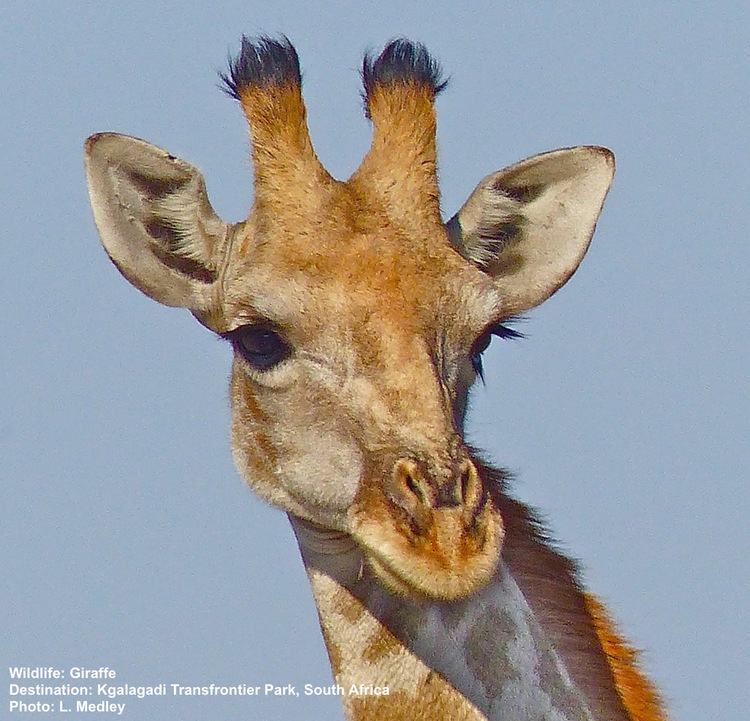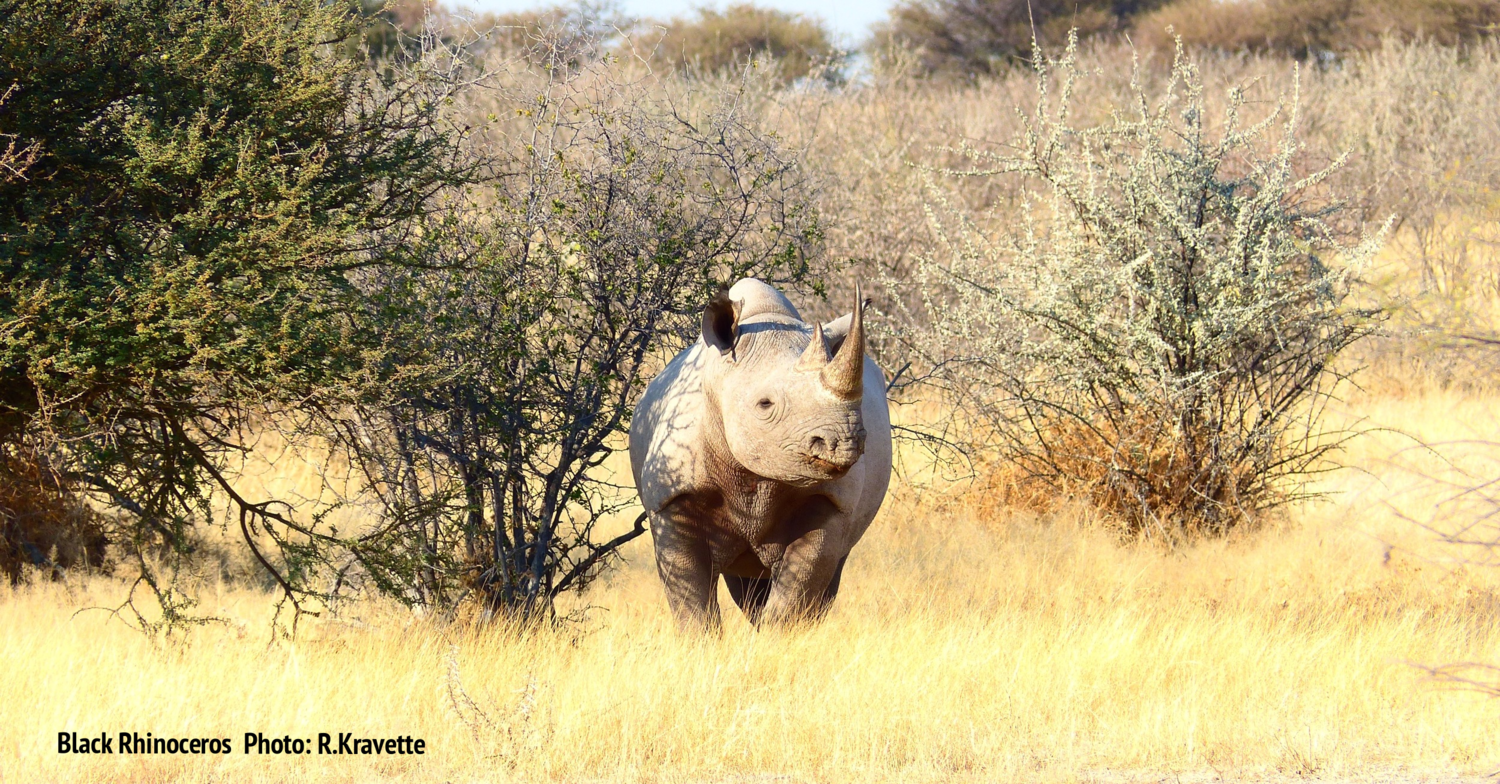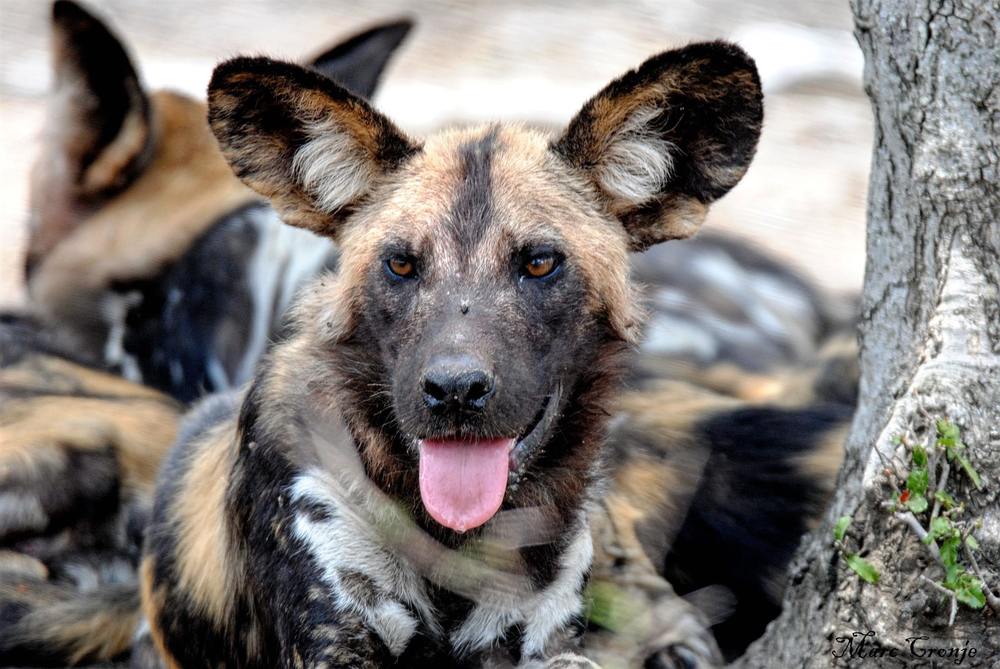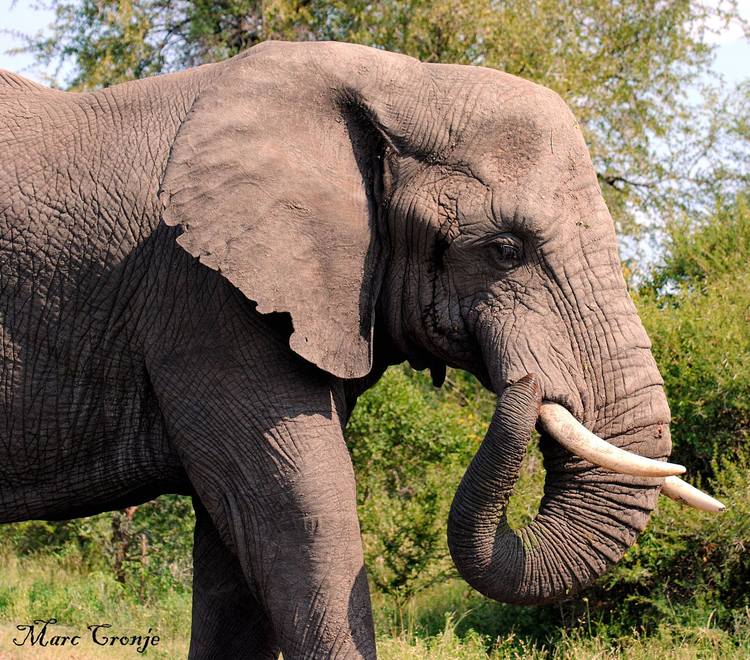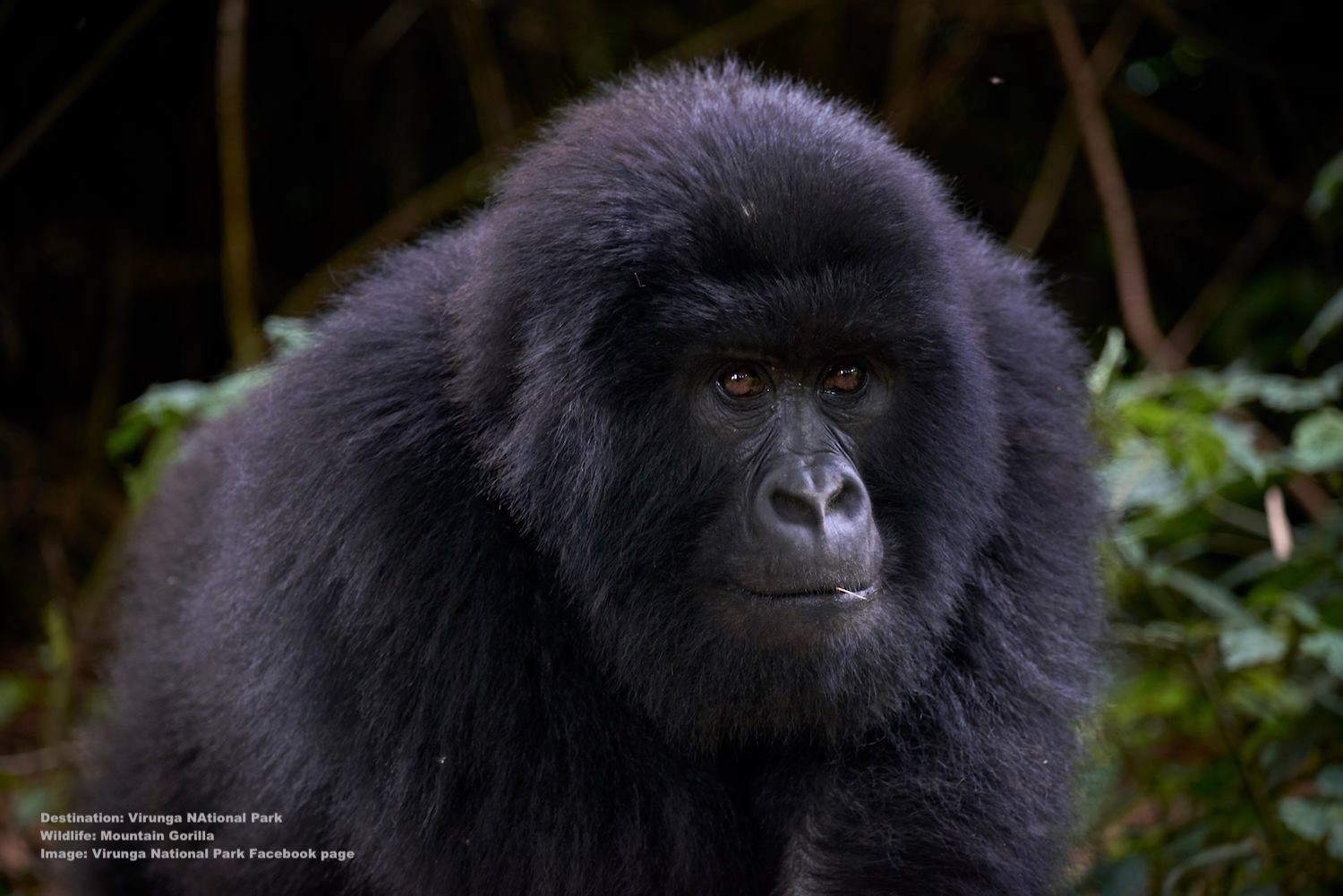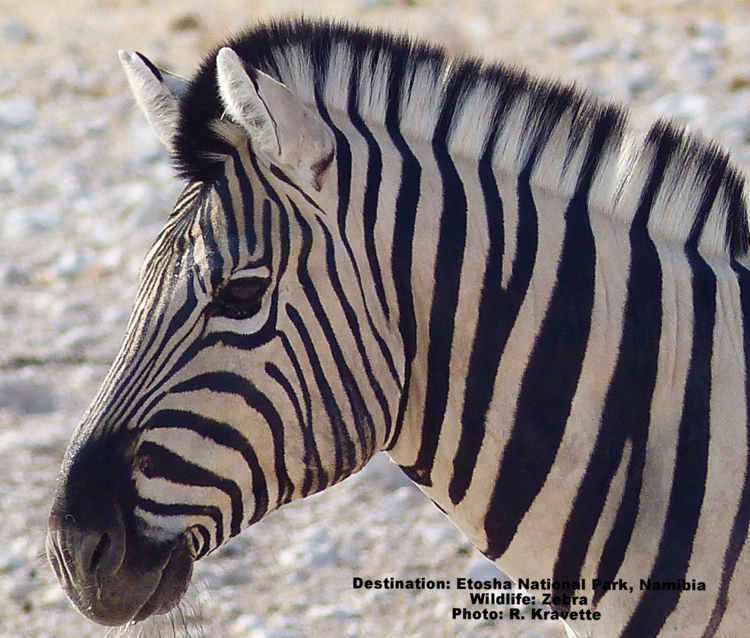WHY CHOBE NATIONAL PARK? ELEPHANTS! THE LARGEST REMAINING HERDS IN THE WORLD. Image: ©Tobie1953⎮Dreamstime.com
The oxpecker must not have heard about Cape buffalo's limited sense of humor. Image: © HKratky⎮Dreamstime.com
Why You Will Love Chobe
Elephants! The continent's largest herds, Cape buffalo too.
Lion Behavior: Some prides have an unusual appetite for elephants and hippopotamus.
Africa's Longest Big Mammal Migration: Recently discovered, zebras travel 300 miles (480 km) from Namibia to Botswana (Chobe).
The River: Chobe River front (river cruises!) + three other distinct eco-systems.
The Scoop on Chobe National Park
Experiencing Chobe National Park’s four distinct eco-systems is like visiting four different destinations on one. But give yourself time, this park covers over 4,500 square miles (11,700 sq. km.) and features unparalleled wildlife watching.
Mother and baby giraffe (calf) in the savannah forest of Savute Marsh area, Chobe National Park. ©Prillfoto⎮Dreamstime.com
1. The Serondela Area: Also known as the Chobe River front, the north-east section of park consists of lush plains and dense forests. Expect to see elephants and Cape buffalo.
2. The Ngwezumba pans: This area is hot and dry, but the pans usually hold water well into the dry season. The best time to visit is August through October
3. Suvuté Marsh: Located in the western section of park, the Suvuté Marsh consists of thick grasslands and savanna forest.
4. Linyanti Regions: Also located in the western section of park, these areas include the Linyanti River and nearby marshes and also dry woodlands. The big predators are partial to this area, as well as the elephants and buffalo.
Chobe's huge variety of wildlife and birds includes Africa’s largest surviving population of elephants (120,000 individuals). These elephants are migratory, moving 125 miles (200 km.), from river to pans within the park seasonally.
Chobe National Park is one of the last places to see endangered African painted dogs.
Image: ©Ea-4⎮Dreamstime.com
The park is also home to the very rare, endangered African painted dogs. They can be seen in the Linyanti River section of the park near the boarder with Namibia.
Plan enough time to visit all four regions to fully experience the widest array of animal and bird behaviors in different habitats. For a very different safari experience enjoy a river cruise and watch the animals from on the water. Or take a sundowner cruise for the magnificent African sunset.
Chobe's Wild Side: What to See
Why Chobe National Park? Elephants! The largest remaining herds in the world. Image: ©Mrallen⎮Dreamstime.com
Wildlife in Chobe National Park
African painted dog, blue wildebeest, Cape buffalo, civet, crocodile, giraffe, hippopotamus, hyena, leopard, lion, puku (a type of antelope, assessed Near Threatened), savanna elephant, tseessebe, zebra, and much more.
Bird-Watching in Chobe National Park
Over 400 bird species including eagles: fish and Marshal, Sacred Ibis, Pell’s fishing owl, carmine bee eaters, all the roller and most of the king fisher species, spur winged and Egyptian geese,
many different storks and other wading birds.
Being Responsible in Chobe
At one time, Botswana’s Department of Wildlife and National Parks (DWNP) was considering certain steps, including regulating entry times and volume, to preserve their habitats and avoid the over crowding that spoils the wildlife experience at certain other of Africa’s famous parks. Check the park’s latest rules prior to arrival. If you are using an official guide they will plan accordingly.
See the end of article for Chobe’s Code of Visitor Conduct for game drives as of 2012. It is largely common sense and applicable to most wildlife areas. We are including it here because it gives you an idea of best practices for your visits to other parks, too.
Best Time to Visit Chobe
The Dry Season: July to October
This is the sweet spot. The dry season usually extends from May to early November, and game viewing along the Chobe River and Savuté is prime. It can get hot starting in August, so plan accordingly.
The Rainy Season: December to March
The rainy season. Great for bird watching and seeing the zebra migration in Suvuté. The impala give birth during this time, so the predators are very active, too.
Discovered to be the longest big mammal migration in Africa : Zebras travel 300 miles (483 km) from Namibia to Botswana - and right through Chobe. See them at the Savute Marsh area. Image: ©Ea-4⎮Dreamstime.com
Accommodations
There are lodges and campsites both inside and outside the park.
Why stay inside the park? Earlier and longer access to the reason you are there: Wildlife! Image: ©Forgiss⎮Dreamstime.com
Inside: Best reasons to stay inside the park – best access to wildlife viewing. You are already inside the gates when they open in the morning, and the lodges offer game drives after the park is closed for the evening. These times are when the animals are most active, so that is a great advantage.
Outside: Best reasons to stay outside the park: Many of the park lodges do not welcome self-drivers, and there is a greater range of accomodations.
Lodges Inside Chobe National Park: Chobe offers both lodges and tented camps. Each extends all-inclusive packages – BUT – some may not welcome self-drive visitors. Please research in advance.
Chobe Game Lodge - A Sustainable and Accessible Standout: Built in 1972, when considerations such as sustainability and universal access were not on most business agendas, Chobe Game Lodge has become a leader in both fields. It features a foundation built with bricks made from recycled glass, and the decking of their famous boardwalk is made of recycled plastic bags. Ninety-five percent of their total waste is recycled; some of it is turned into biogas on site, which is then used as kitchen fuel. The lodge’s grounds are irrigated with reprocessed grey water, and they operate the first CO2 emission free safari fleet (4x4 game viewerrs and safari boats).
Chobe Game Lodge welcomes families with children and physically disabled guests. There is accommodation for wheelchair bound guests including special mobile safari vehicles. The lodge is located on the northwest corner of the park on the banks of the Chobe River at the Namibian border.
Camping: Public and tour operator campsites are available inside the park, but the number of sites and spaces is limited. Booking in advance is advisable. Being this close to nature, seeing a sky full of stars while sitting around the cozy campfire, hearing the fascinating night sounds, can all be memorable experiences. Remember that the wildlife in Chobe is wild and do enter the campsites. Understand and follow all rules and recommendations for camping in Chobe.
Even if you are not a "birder" some of Chobe's species, like this African fish eagle, are amazing. Image: ©Tobie1953⎮Dreamstime.com
Something Special: House Boats
For an unusual experience try sleeping on the Chobe River instead near it. The view from the boat is a totally different wildlife watching experience. The boats are small and some of them can even be reserved by one family or a couple (great honeymoon idea!).
The Chobe River, which runs between Namibia and Botswana, is considered international territory. You will be cleared by immigration, then transported to the houseboat by a small tender.
Also in Botswana
Victoria Falls (from the Zimbabwe side). A short drive from Chobe National Park. Image: ©Stephanie van Der Vinden⎮Dreamstime.com
Botswana is filled with natural and cultural wonders to explore. The following are physically close to Chobe.
Okavango Delta
UNESCO World Heritage listed for its “unique universal value.” Visit and see why. The delta, a combination of permanent swamps and grass lands, floods in the dry season. Its amazingly diverse flora and fauna have adapted their biorhythms to the delta’s unique annual cycle. This is as pristine a wilderness area as you can find anywhere on the planet today – and one not to be missed.
Victoria Falls
Yes, this is in Zimbabwe, but very close and amazing, and the boarders are friendly, so try not to miss it. One of the biggest waterfalls on the planet, it is locally called, “ Mosy-oa-Tunya” which means “Smoke that thunders”. Go see why. Victoria Falls is about a 1.5-hour drive west of Chobe.
Be Prepared
The river makes Chobe a "don't miss" destination - but you will share it with mosquitos. Prepare before you travel. Image: ©Artushfoto⎮Dreamstime.com
Language
Botswana’s official language is English, the most spoken native language and the one used in most homes (90%) is Setswana. There are also about 20 other languages spoken regionally or tribally.
Visa Requirements
According to the Botswana embassy web site, the list of countries that DO NOT require Visas is extensive (108 at last count) and include: U.S., Canada, United Kingdom, and Russia. There is also a list of countries that DO require Visas (93).
Check with your country’s Botswana Consulate, prior to finalizing your plans, for the latest requirements.
Health Notes
According to the US Center for Disease Control (CDC): “Make sure you are up-to-date on routine vaccines before every trip. These vaccines include measles-mumps-rubella (MMR) vaccine, diphtheria-tetanus-pertussis vaccine, varicella (chickenpox) vaccine, polio vaccine, and your yearly flu shot.”
Hepatitis A: Vaccination Recommended
Typhoid: Only if visiting small cities, friends or relatives or are “an adventurous eater”.
Yellow Fever: According to the CDC, there is no risk of contracting yellow fever, however, depending on your departure country, you may have to produce proof of vaccination.
Malaria: Chobe National Park is wet; you will encounter mosquitos. Chobe is a recognized known malaria zone. Contact your doctor for the best course of action for you. Bring and use mosquito repellant and long sleeved and long legged clothing to use, especially early in the day and at dusk when the mosquitos are most active.
Did you know? The hippopotamus is considered the most dangerous mammal in Africa? Watch from a distance and never come between them and the water. Image: Tobie1953dreamstime.com
Over crowding and irresponsible behavior makes for a less enjoyable experience for humans and a more stressful environment for the wildlife. Chobe posts rules at the entrances like this one. They also have a Code of Conduct for visitors. Image: ©Antonella865⎮Dreamstime.com
Chobe National Park's
"Code of Visitor Conduct"
1. Entry into the park should always be at designated entry points where payments are made.
2. A reasonable following distance of 300 to 500m should be kept between vehicles.
3. Maximum driving speed should be 40km/hr.
4. Only four vehicles are allowed per sighting and a maximum of 5 minutes should be spent by each vehicle.
5. Parking should be done with two side wheels on the road and the other two side wheels off the road to avoid off-road driving.
6. DRIVING OFF THE ROAD IS STRICTLY PROHIBITED.
7. Minimize disturbance to animals to avoid willful obstruction to other park users.
8. Do not inform another of a sighting through a mobile device, radios and/or cell phones are for emergency purposes only.
9. Respect the animal’s living space; do not go too close to animals.
10. The first person at the sighting should be given priority, never block another vehicle.
11. Always stick/park to the side where the sighting is, to give way to other vehicles.
12. Slow down to avoid accidents and unnecessary dust when you approach another vehicle head on.
We’d like to add: Stay in your vehicle while on a game drive. Predators are not likely to attack a vehicle – even an open sided one. They will however, see a relatively scrawny human (lions can weight a well-muscled 250 – 450 pounds) as an easy meal option. Unfortunately for the lion, your mistake means it will have to be shot.
Chobe National Park is a wonderful place to see large herds of elephants exhibiting a wide range of behaviors, like these swimming across the river in the Savute Marsh area. Image: © Aajiedejong⎮Dreamstime.com


